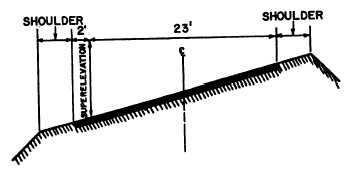Figure 3-7.-Curve section.
section for a curve, the pavement is a plane surface
instead of crowned and is usually superelevated to
account for centrifugal force encountered in curves. The
outside shoulder slope is the same as the superelevated
pavement slope, but the inside shoulder slope is either
the same or greater slope. (Inside shoulder refers to the
shoulder closest to the center of the arc, or curve.)
Most curves are also widened on the inside to allow
for the “curve straightening” effect of long wheelbase
vehicles. The back wheels of the trailer in a
tractor-trailer rig do not follow in the tracks of the tractor
wheels. They run closer to the inside edge on the inside
lane and closer to the centerline on the outside lane. This
presents a safety hazard when two vehicles meet in
curves. Curve widening partially eliminates this hazard.
Figure 3-7 is a superelevated section showing curve
widening. Specific guidance for curve widening is
contained in NAVFAC DM-5.5.
Preliminary Cross Section
Preliminary cross sections are sectional views of
the existing terrain taken at each station point along the
center line of the route the road is to take. These sections
are usually taken after the roadway has been cleared but
may be taken before. If the sections are taken before, the
thickness of the sod to be stripped off is normally
deducted from the elevations. The preliminary cross
section shows the elevations of the natural, or original,
ground. These sections, when superimposed on the
desired finished roadbed sections, are used for studying
various alignments of the road and for preliminary
earthwork estimating. Figure 3-8 shows typical
preliminary cross sections.
Figure 3-8.—Preliminary cross sections.
3-9









